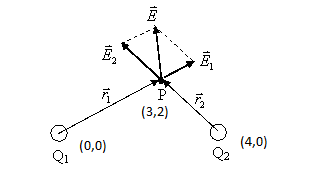Superposition Principle: Difference between revisions
No edit summary |
(→Simple) |
||
| Line 26: | Line 26: | ||
===Simple=== | ===Simple=== | ||
[[File: | [[File:BrooksEx1.png]] | ||
===Middling=== | ===Middling=== | ||
Revision as of 01:13, 5 December 2015
The Superposition Principle states that the net result of multiple vectors acting on a given place and time is equal to the vector sum of each individual vector. For intro physics, this mostly relates to effect that multiple electric or magnetic fields and forces have on a certain location.
A Mathematical Model
The Superposition Principle is derived from the properities of additivity and homogeneity for linear systems which are defined by
[math]\displaystyle{ F(x_1 + x_2) = F(x_1) + F(x_2)\quad Additivity }[/math]
[math]\displaystyle{ aF(x) = F(ax)\quad Homogeneity }[/math]
for a scalar value of a. The principle can be applied to any linear system and can be used to find the net result of functions, vectors, vector fields, etc. For the topic of introductory physics, it will mainly apply to vectors and vector fields such as electric forces and fields.
If given a number of vectors passing through a certain point, the resultant vector is given by simply adding all the the vectors at that point. For example, for a number of uniform electric fields passing though a single point, the resulting electric field at that point is given by
[math]\displaystyle{ \vec{E} = \vec{E}_{1} + \vec{E}_{2} +...+ \vec{E}_{n} = \sum_{i=1}^n\vec{E}_{i} }[/math]
and this same concept can be applied to electric forces as well as to magnetic fields and forces. This is more useful when dealing with the effect that multiple point charges have on each other is an area of void of other electric fields. The resultant electric field for at a point for a system of point charges is given by
[math]\displaystyle{ \vec{E} = \frac{1}{4 \pi \epsilon_0}\sum_{i=1}^n\frac{q_i}{r_i^2}\hat{r_i} }[/math]
This approach can be applied to any other sources of electric or magnetic field or force by simply adding together the each of the vectors at a specific point
Examples
Be sure to show all steps in your solution and include diagrams whenever possible
Simple
Middling
Difficult
Connectedness
- How is this topic connected to something that you are interested in?
- How is it connected to your major?
- Is there an interesting industrial application?
History
Put this idea in historical context. Give the reader the Who, What, When, Where, and Why.
See also
Are there related topics or categories in this wiki resource for the curious reader to explore? How does this topic fit into that context?
Further reading
Books, Articles or other print media on this topic
External links
References
This section contains the the references you used while writing this page
